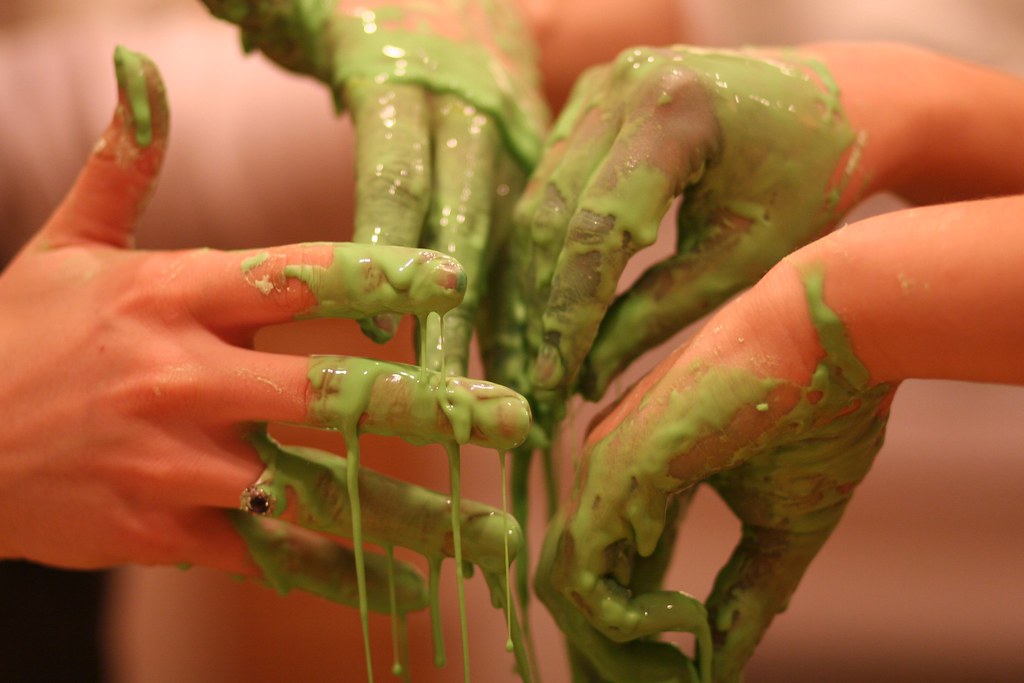Make Your Own Oobleck at Home: All Ages

Is it a liquid or a solid? Can it be both at the same time?
Oobleck is a mixture of cornstarch and water. Since the cornstarch does not dissolve in water, it remains suspended, and the water is able to move in between the cornstarch particles.
One of the cool things about oobleck is that sometimes it behaves like a solid and sometimes like a liquid. When the pressure is applied, it behaves like a solid, and when it is left to rest, it behaves like a liquid.
Vocabulary:
- Suspension
- Solid
- Liquid
- Slime
- Newtonian liquids
Materials
Cornstarch
Water
Large mixing bowl(s)
Spoon(s)
Liquid Watercolor (optional) – we do not recommend food coloring, as it might stain clothes and skin
Directions
- Pour a semi-large amount of corn starch into the bowl.
- OPTIONAL – add liquid watercolor to the water.
- Now pour the water in, mixing slowly as you go. Keep adding more water until the mixture
becomes thick (and hardens when you tap on it). Add more cornstarch if it gets too runny, and more water if it becomes too thin.
Options of things to do with Oobleck:
- Skim your finger across the top of the glop. What do you notice?
- Sink your entire hand into the glop and try to grab the fluid and pull it up.
- Try to roll the fluid between your palms to make a ball.
- You can even hold your hand flat over the top of the pan and slap the liquid glop as hard as you can. Most children will run for cover as you get ready to slap the liquid, fearing that it will splash everywhere. Fear not, all of the glop stays in the pan…hopefully. If your mixture inadvertently splatters everywhere, you will know to add more cornstarch.
- As your child(ren) play with the glop, ask them to speculate as to why the liquid behaves in this manner. What causes it to feel like something solid when you squeeze it, yet flow like syrup as it drips off your finger?
What’s Happening?
How does glop act like a solid sometimes and a liquid at other times? Actually, glop is an example of what is called a Non-Newtonian fluid – a fluid that defies Isaac Newton’s law of viscosity. All fluids have a property known as viscosity. It is the measurable thickness or resistance to flow in a fluid. Honey and ketchup are liquids that have a high resistance to flow.
When I think of viscosity, I always remember the television commercial of the child who is patiently waiting for the ketchup to flow out of the bottle and onto the hamburger bun. Be thankful that the viscosity of the ketchup is greater than that of water the next time you are sitting across the table from somebody who is pounding on the bottom of the ketchup bottle.
Newton stated that the viscosity of a fluid can be changed only by altering the fluid’s temperature. For example, motor oil or honey flows more easily when you warm it up and becomes very thick when it gets cold. So, a Non-Newtonian fluid has the same dependence on temperature, but its viscosity can be changed by applying pressure. When you squeeze a handful of glop, its viscosity increases so it acts like a solid for a split second. When you release pressure, the glop behaves just like a liquid.
Ironically, the cornstarch will not stay mixed with the water indefinitely. Over time, the grains of cornstarch will separate from the water and form a solid clump at the bottom of the plastic storage bag. It is for this reason that you must not pour this mixture down the drain. It will clog the pipes and stop up the drain. Pour the mixture into a zipper-lock bag and dispose of it in the garbage.
Source and see more: Steve Spangler Science






